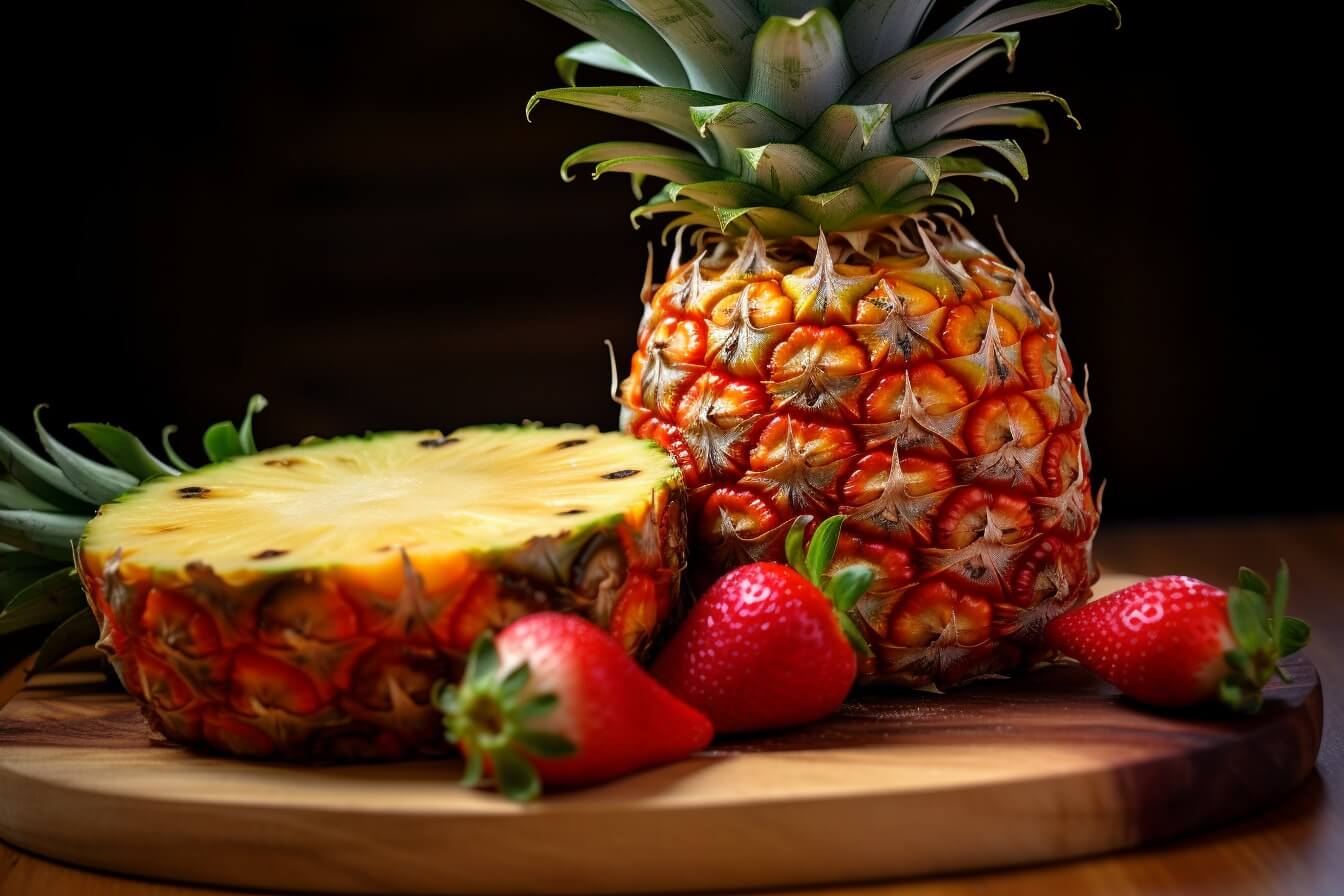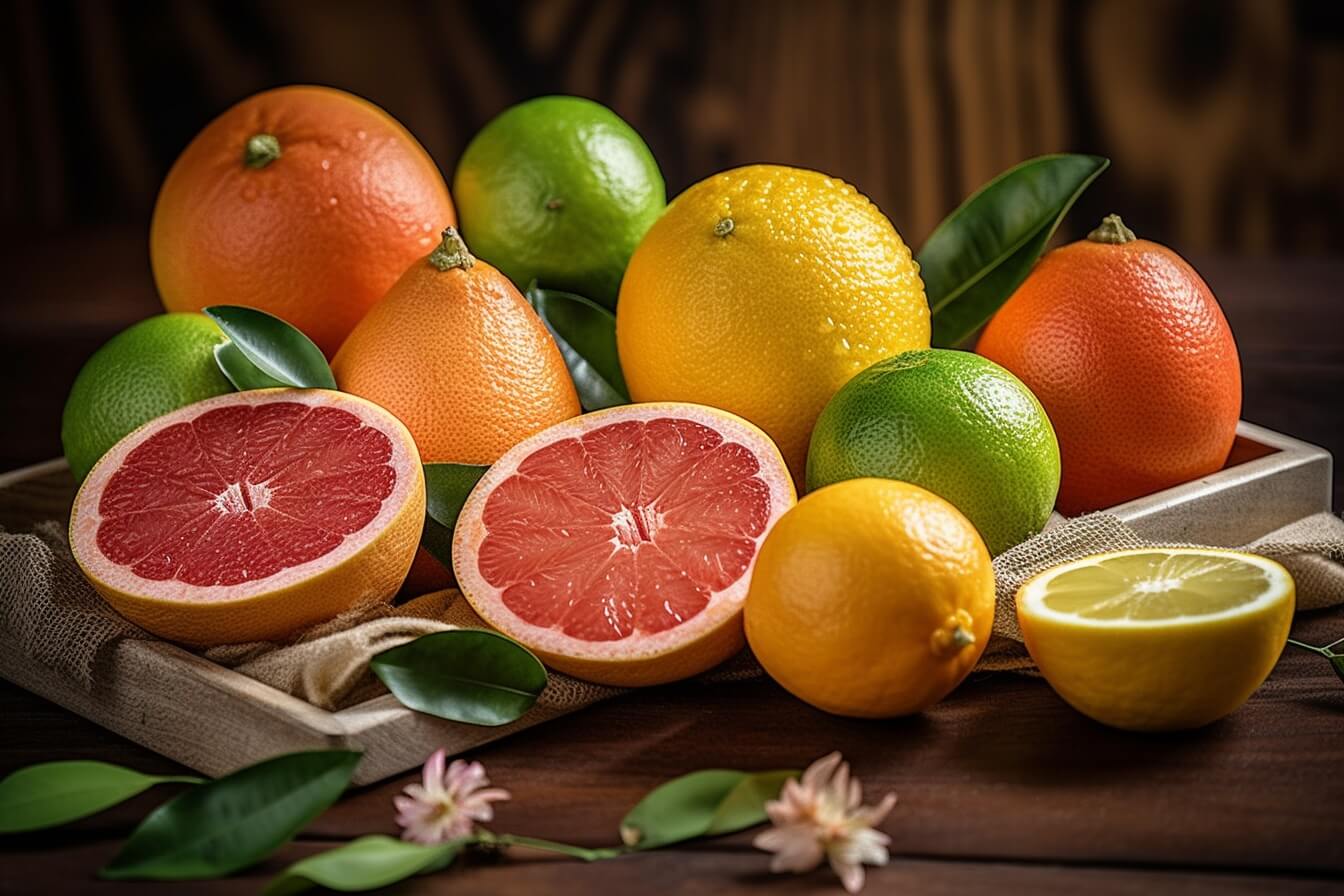Pineapple is a tropical fruit that is often compared to citrus fruits due to its tangy and sweet taste, but it is not actually a citrus fruit – read on to learn more about this juicy and nutrient-packed fruit.
Pineapple, scientifically known as Ananas comosus, is a popular tropical fruit native to South America. This fact was noted by Julia F. Morton in her book “Fruits of Warm Climates” (1987). Often referred to as “ananas” in many languages, it features an edible fruit that consists of coalesced berries and has a sweet yet tangy flavor.
This delicious and refreshing fruit boasts several health benefits; it’s packed with vitamin C, dietary fiber, essential nutrients like manganese, and contains enzymes such as bromelain which aids digestion and combats inflammation in conditions like rheumatoid arthritis, as reported in the Journal of Ethnopharmacology (1988).

Common Characteristics Of Citrus Fruits
Citrus fruits, such as oranges, lemons, and grapefruits, share several key features that set them apart from other fruits. These characteristics are detailed in “Biology of Citrus,” a book by P. Spiegel-Roy and E. E. Goldschmidt (1996). Some of these common characteristics include:
- Belonging to the hesperidium subtype of berries
- Pulpy, sectioned insides
- Peelable, spongy or firm skin
- High levels of Vitamin C (ascorbic acid)
- Juicy and acidic taste
- Grown in tropical climates
- Popular fruit salad ingredients due to their refreshing flavors
- Containing essential oils in their peels that offer a variety of health benefits
- Providing numerous nutritional benefits, such as dietary fiber and essential nutrients
- Known for helping lower cholesterol levels, treat rheumatoid arthritis symptoms, and boost immunity

Comparison Of Pineapples And Citrus Fruits
Both pineapples and citrus fruits are considered berries, contain citric acid, and offer similar health benefits such as aiding in digestion and providing essential nutrients.
1. Both Are Berries
One intriguing similarity between pineapples and citrus fruits is that they are both classified as berries. This botanical classification is explained in “Plant Systematics: A Phylogenetic Approach” by W. S. Judd et al. (2002). In botanical terms, a berry is a fleshy fruit that develops from a single ovary of an individual flower, containing seeds in its interior.
Citrus fruits like oranges, lemons, and grapefruits also belong to the berry category due to their segmented flesh encasing several seeds within their juicy layers.
For example, when you slice open an orange or a grapefruit, you’ll notice how each segment holds numerous tiny seeds surrounded by juicy pulp.
2. Both Contain Citric Acid
Citric acid, a naturally occurring organic compound found in many fruits, is a key factor contributing to the tart and sour taste that both pineapples and citrus fruits share. This information is found in “Edible Medicinal And Non-Medicinal Plants: Volume 4, Fruits” by T. K. Lim (2012).
This ingredient is often used as a flavoring agent and preservative in food products due to its acidity.
Interestingly, the presence of about 8% citric acid in pineapples (as mentioned by Drugs.com) has led some people to mistakenly believe that pineapples are part of the citrus family. Despite this similarity in taste profiles, it’s important to remember that the biological classification of these two fruit types differs significantly.
Nonetheless, both pineapples and common citrus fruits like oranges or lemons can offer nutritional benefits linked with increased levels of citric acid – including improved digestion and immune support.
3. They Have Similar Health Benefits
Both pineapple and citrus fruits have similar health benefits that make them a great addition to any diet. They are both rich in dietary fiber, which can help regulate digestion and keep you feeling full for longer periods of time.
Additionally, one cup of pineapple contains about 80 milligrams of vitamin C, which meets 88 percent of recommended daily intake, according to USDA Food Data Central.
In a study published in Biomedicines (2020), it was found that consuming pineapple juice regularly may help lower cholesterol levels and reduce inflammation throughout the body. Meanwhile, citrus fruits like oranges and grapefruits have been linked to reducing the risk of rheumatoid arthritis due to their anti-inflammatory properties, as reported in the Annals of the Rheumatic Diseases (2004).

4. They Have Different Botanical Classification
Pineapple and citrus fruits belong to different families from a botanical classification perspective. While citrus fruits fall under the Rutaceae family, pineapple belongs to the Bromeliaceae family, as listed in the “World Checklist of Bromeliaceae” by Royal Botanic Gardens, Kew (2016).
This difference impacts their growing conditions as well: while most citrus fruits grow on trees or shrubs, pineapples are grown in soil or hydroponic environments.
Moreover, unlike many of its fruit counterparts, pineapple does not contain any seeds (even though they can be propagated using slices). This was explained in the Annals of Botany (2019) in an article titled “How Do Pineapples Grow?”. Pineapples also do not have starch reserves that convert into sugar after harvesting like other fruits such as pears and stone fruit.
